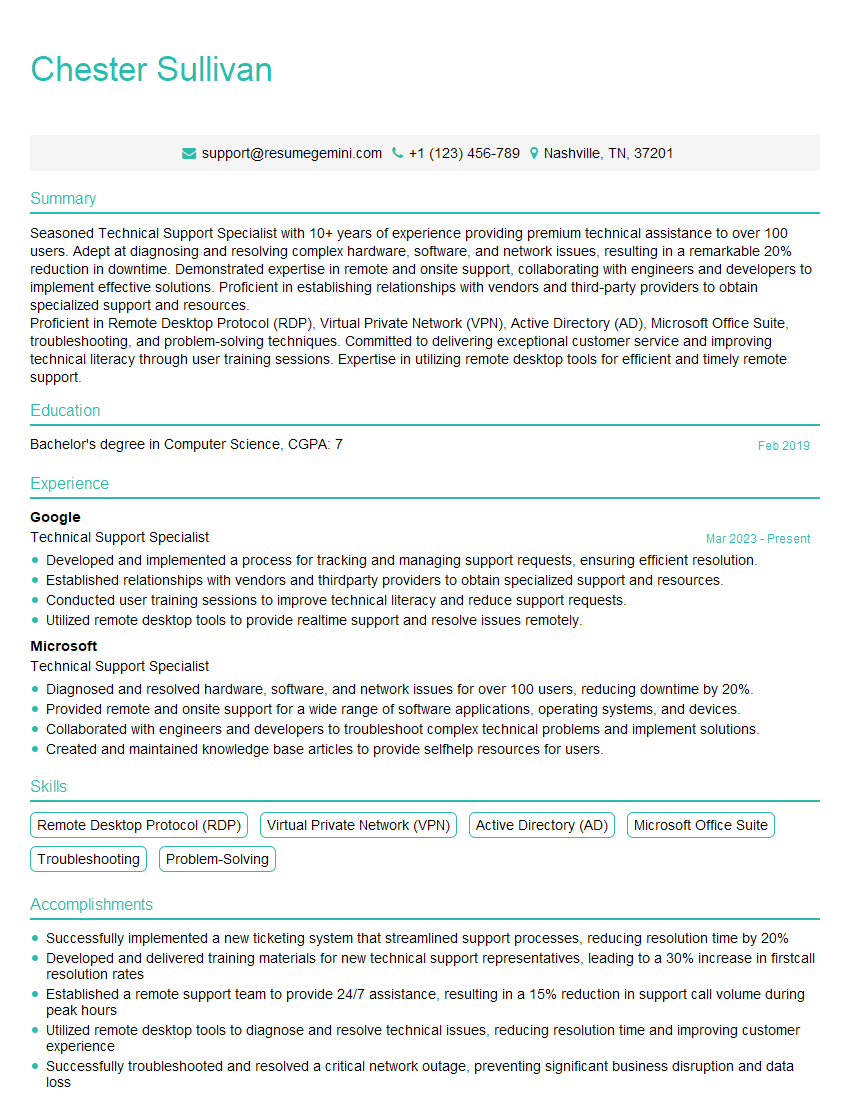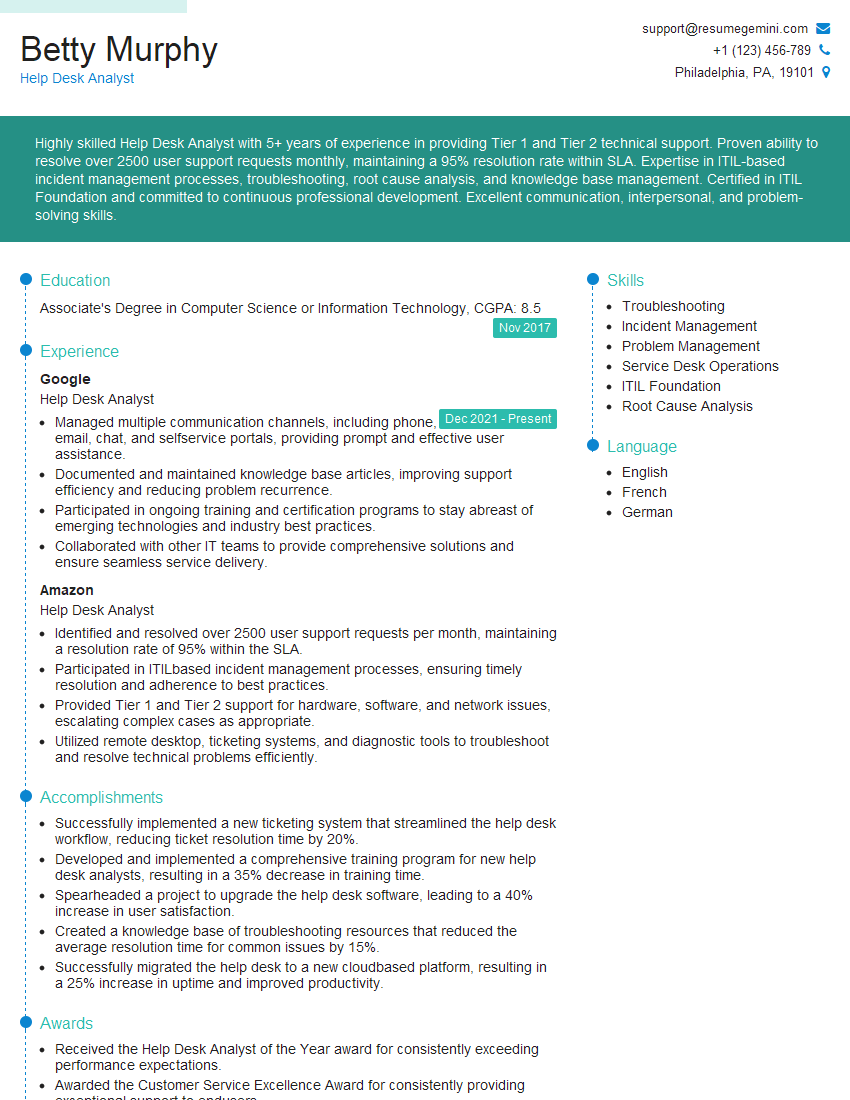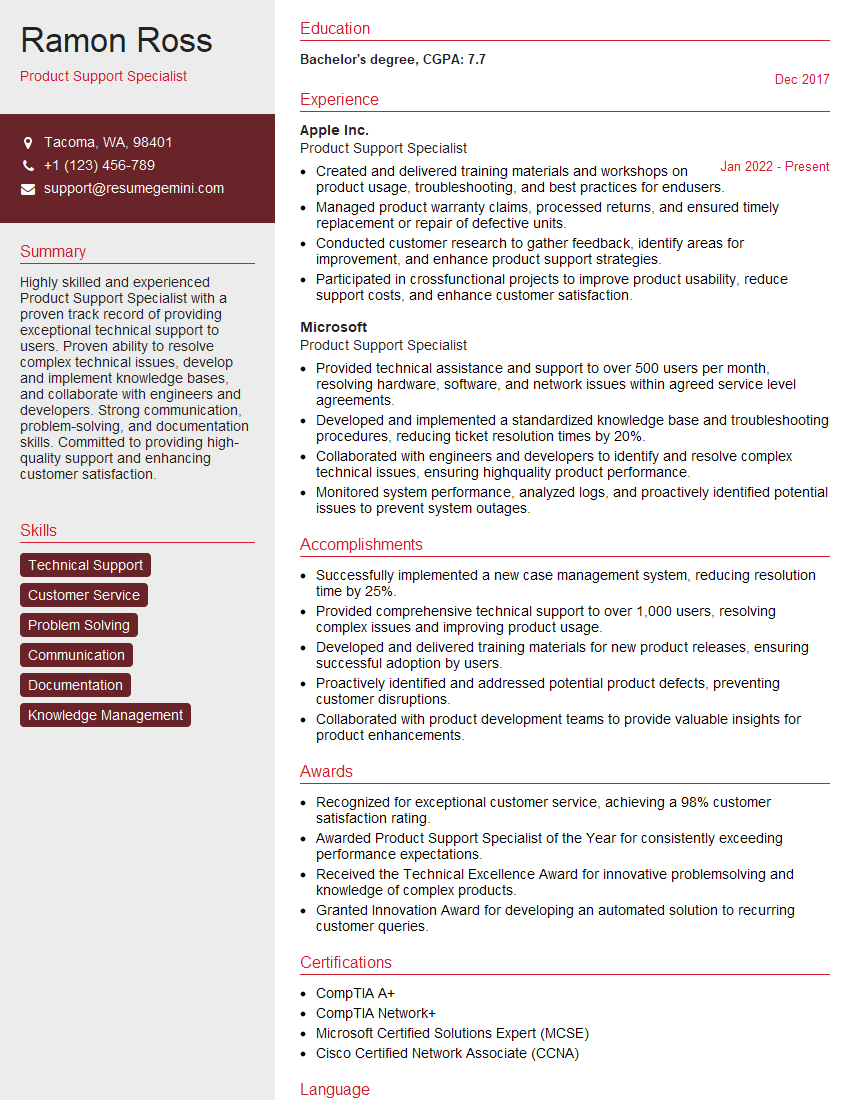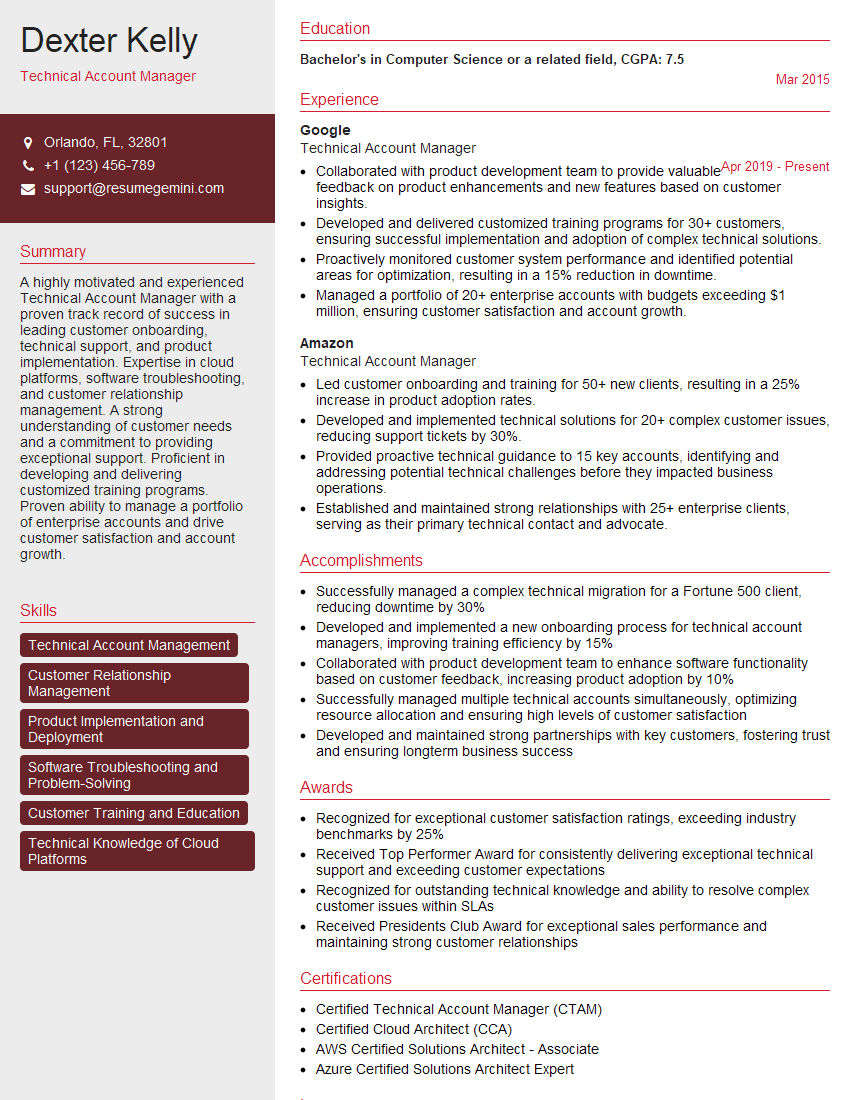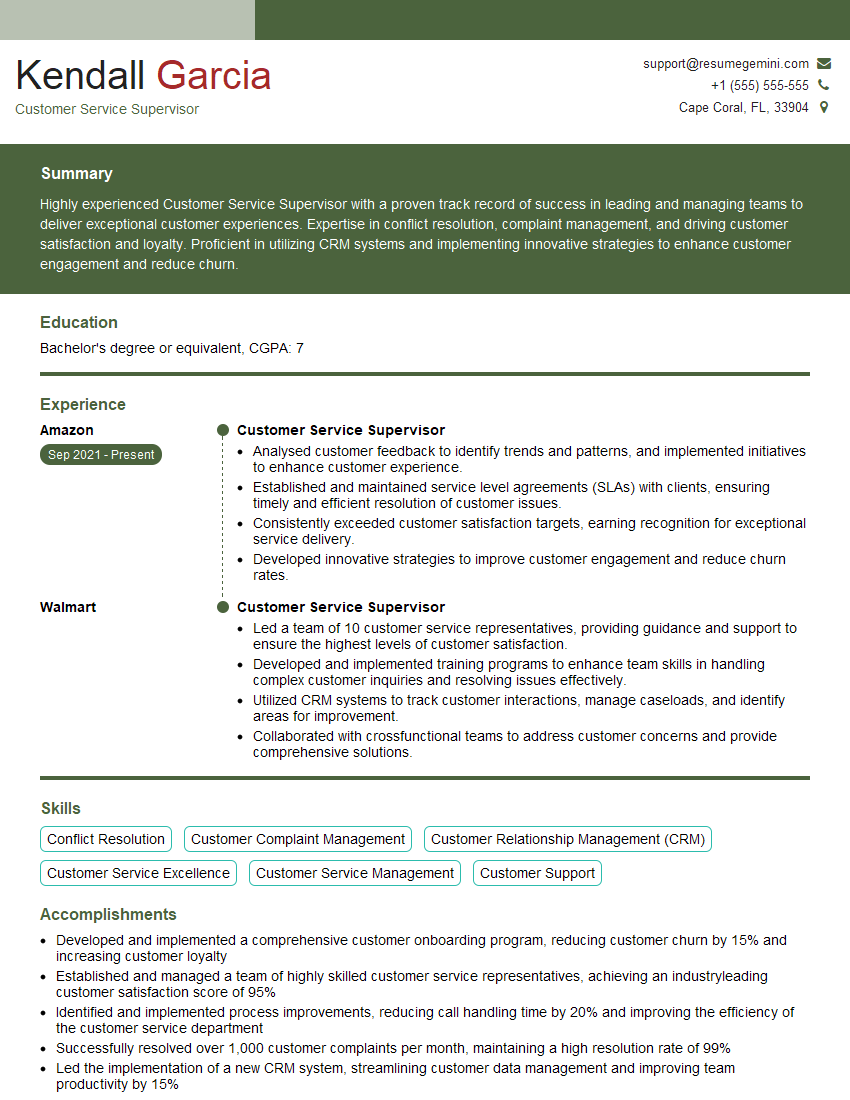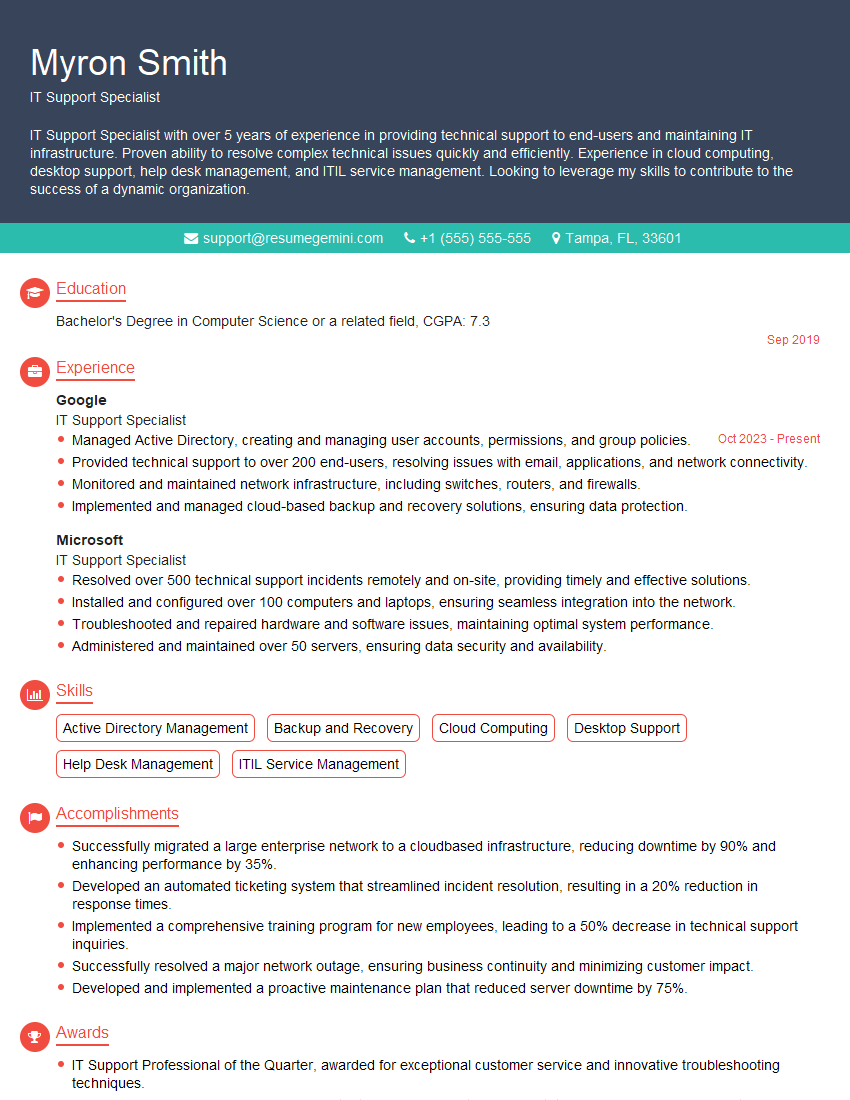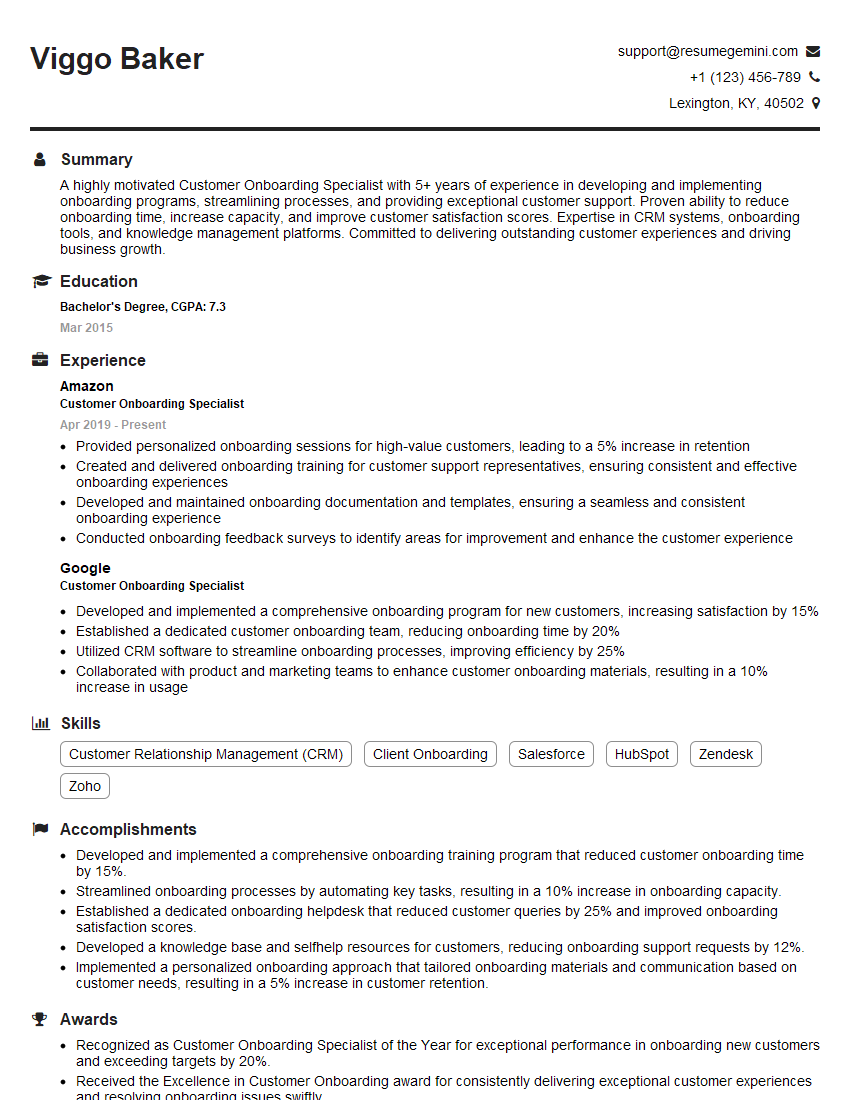The thought of an interview can be nerve-wracking, but the right preparation can make all the difference. Explore this comprehensive guide to Identify and resolve customer issues interview questions and gain the confidence you need to showcase your abilities and secure the role.
Questions Asked in Identify and resolve customer issues Interview
Q 1. Describe your process for identifying the root cause of a customer issue.
Identifying the root cause of a customer issue is a systematic process that requires careful investigation. I approach it using a structured method, often resembling a detective’s approach. First, I actively listen to the customer’s description of the problem, asking clarifying questions to ensure I fully understand the situation. This includes gathering specifics like error messages, timestamps, steps taken before the issue occurred, and the customer’s environment (e.g., operating system, browser). Then, I systematically eliminate possibilities. I start with the simplest explanations, checking for obvious issues like incorrect configurations or network connectivity problems. If the problem persists, I delve deeper, using diagnostic tools and logs to pinpoint the source of the malfunction. This might involve reviewing system logs, inspecting database entries, or running performance tests. I document each step and finding meticulously. Once I have identified the root cause, I create a comprehensive explanation to ensure the customer understands the issue and the solution.
For example, if a customer reports slow website loading times, I wouldn’t jump to conclusions about server issues immediately. I’d first check their internet connection speed, browser cache, and installed extensions. If those are fine, I’d look at website server logs and performance metrics to identify bottlenecks. It could be a database query issue, a poorly optimized code section, or a network problem on the server side. The systematic elimination helps isolate the true source of the slowdown.
Q 2. How do you prioritize multiple customer issues simultaneously?
Prioritizing multiple customer issues requires a well-defined strategy. I use a combination of urgency and impact assessment. I employ a system where I assign each issue a priority level based on two main factors: urgency (how quickly the issue needs to be resolved) and impact (how many customers are affected or the severity of the issue). For instance, a critical issue affecting many users, like a system outage, takes precedence over less urgent individual user problems. I use a ticketing system to manage and track all these issues, visually categorizing them by priority. This ensures that the most pressing issues receive immediate attention, and allows me to efficiently manage my workload without compromising the quality of support provided to each customer.
Think of it like a triage system in a hospital. Life-threatening injuries get immediate attention, followed by serious injuries, and then minor ones. Similarly, critical system failures require immediate resolution, while minor cosmetic issues can be addressed later.
Q 3. Explain a time you had to escalate a customer issue. What was your approach?
I had to escalate a customer issue when a client experienced a persistent data loss problem in our application. After thoroughly investigating the issue, I determined that the problem stemmed from a rare software bug in a third-party library our application used. Given my limited access and expertise in fixing such low-level issues, I documented all my findings – steps I took, logs I reviewed, error messages encountered – in a detailed report. Then I contacted our development team, clearly explaining the issue, its severity (data loss for a valued client), and attached the comprehensive report. I maintained regular communication with both the client and the development team, providing updates and ensuring the client felt heard and supported throughout the escalation process. We worked together to resolve the issue, and I helped the client implement temporary workarounds during the resolution period.
My approach hinges on clear communication, detailed documentation, and maintaining a collaborative relationship between all parties involved. Escalation isn’t about shifting blame; it’s about leveraging the collective expertise of the team to find the most effective solution.
Q 4. How do you handle difficult or angry customers?
Handling difficult or angry customers requires empathy, active listening, and a calm demeanor. The first step is to actively listen to their concerns without interruption. Once they’ve had a chance to vent, I validate their feelings by acknowledging their frustration. I might say something like, “I understand your frustration; this is certainly inconvenient.” Then, I shift the conversation to finding a solution. I clearly explain what I can do to help, setting realistic expectations. If I cannot immediately resolve the issue, I provide a timeline for a resolution and follow up regularly. Maintaining a professional and empathetic tone throughout the interaction is crucial. If the customer continues to be abusive, I’ll politely but firmly remind them of acceptable communication standards.
Imagine a doctor treating a patient in pain. The doctor doesn’t dismiss the pain; they address it, offer comfort, and then work on a treatment plan. Similarly, I aim to understand the customer’s anger, address their concerns, and find a resolution.
Q 5. What troubleshooting techniques are you proficient in?
My troubleshooting techniques are comprehensive and adapt to the situation. I’m proficient in using various diagnostic tools, including network analyzers (like Wireshark) to identify network connectivity problems, and debugging tools to pinpoint code errors. I’m skilled in analyzing system logs, database queries, and performance metrics to identify bottlenecks. I can effectively use remote desktop tools to access and troubleshoot customer systems directly. My experience includes working with different operating systems (Windows, macOS, Linux), web browsers, and various software applications. I also utilize a structured approach—starting with simple checks and gradually moving towards more complex diagnostics, ensuring a methodical and efficient process.
For example, I’ve used Wireshark to diagnose network connectivity issues, identifying packet loss and other network-related problems. I’ve used debugging tools to trace code execution and find the source of errors in applications. My experience with various system tools and methodologies allows me to address a wide range of technical problems.
Q 6. How do you document customer issues and resolutions?
Documentation is paramount. I meticulously document every customer interaction, including the initial issue report, all troubleshooting steps taken, the root cause identification, the solution implemented, and the final resolution status. I use a combination of a CRM or ticketing system (explained below) for centralized record-keeping, and detailed notes within each ticket to provide a chronological and comprehensive history of the issue. This documentation is crucial for tracking issues, identifying trends, improving support processes, and ensuring accountability. My documentation style is clear, concise, and easy for others to understand, even if they weren’t directly involved in the issue resolution.
Think of it like a medical chart – it needs to be clear, concise, and provide all the necessary information for anyone to understand the patient’s history and treatment.
Q 7. How familiar are you with using a CRM or ticketing system?
I am highly proficient in using CRMs (Customer Relationship Management) and ticketing systems. My experience includes using various platforms such as Zendesk, Salesforce Service Cloud, and Jira Service Management. I understand the importance of utilizing these systems for efficient ticket management, customer data organization, and tracking issue resolution times. I’m adept at creating and managing tickets, assigning priorities, adding relevant notes, and updating statuses. I can also leverage the reporting features of these systems to generate insightful data on common issues, customer satisfaction metrics, and overall support performance. The ability to effectively utilize these tools is essential for streamlined support operations and improved customer experience.
For example, in Zendesk, I’m comfortable using its features for creating custom workflows, assigning tickets to appropriate teams, and utilizing its reporting dashboards to monitor key metrics. This allows me to manage my workload efficiently and maintain a high level of customer satisfaction.
Q 8. Describe your experience using remote support tools.
I have extensive experience using a variety of remote support tools, including TeamViewer, AnyDesk, LogMeIn, and GoToAssist. My proficiency extends beyond simply connecting to a customer’s system; I’m adept at utilizing these tools’ features to efficiently troubleshoot issues. For example, I regularly use features like screen sharing to guide customers through steps, file transfer to quickly share updates or drivers, and remote control to directly address technical problems. I’m also comfortable using integrated chat and voice communication features within these platforms for seamless collaboration.
Choosing the right tool depends on the situation. For complex issues requiring direct system access, I’d favor a tool like TeamViewer or AnyDesk. For simpler issues, a screen sharing tool with integrated chat might suffice. My selection is always driven by optimizing the customer experience and resolving the problem quickly.
Q 9. What metrics do you use to measure the success of your customer issue resolution?
Measuring the success of customer issue resolution goes beyond simply closing tickets. I use a combination of metrics, including:
- First Call Resolution (FCR): This metric tracks the percentage of issues resolved on the first contact. A high FCR indicates efficiency and customer satisfaction.
- Average Handling Time (AHT): This measures the average time spent resolving an issue, helping identify areas for process improvement.
- Customer Satisfaction (CSAT) scores: Post-resolution surveys allow customers to rate their experience, offering valuable feedback for continuous improvement. I actively seek feedback and strive for consistently high CSAT scores.
- Ticket Resolution Rate: The percentage of tickets resolved within a defined timeframe, indicating overall team effectiveness.
- Repeat Issues: Monitoring the recurrence of similar issues helps pinpoint systemic problems needing solutions. Low repeat issue rates show effective problem-solving.
By tracking these metrics, I can identify strengths, weaknesses, and areas needing improvement in my own performance and the overall customer support process.
Q 10. How do you stay updated on product knowledge and changes?
Staying updated on product knowledge and changes is crucial. I employ a multi-faceted approach:
- Internal Knowledge Base: I actively consult our internal documentation, wikis, and knowledge bases for the latest information on product updates, features, and troubleshooting guides.
- Training Materials: I participate in regular training sessions and webinars offered by the company. This ensures I’m up-to-date on new releases and best practices.
- Product Documentation: I regularly review official product documentation and release notes to understand new features and potential issues.
- Collaboration with Colleagues: I actively engage with colleagues to share knowledge and best practices. This informal learning is invaluable.
- Direct Customer Interaction: Each customer interaction provides a practical learning opportunity, exposing me to real-world challenges and solutions.
This combination of formal and informal learning ensures my knowledge remains current and relevant, leading to more effective problem resolution.
Q 11. Describe a time you went above and beyond to resolve a customer issue.
I once encountered a customer whose business was severely impacted by a critical software failure just before a major deadline. Their usual support channels were unavailable, and the issue was exceptionally complex, involving multiple interconnected systems. While the initial troubleshooting steps didn’t yield immediate results, I went beyond my standard duties.
I spent several hours late into the night collaborating with our engineering team, patiently explaining the situation and guiding them to identify and fix the underlying root cause. I kept the customer updated throughout the process, offering frequent, transparent communication to alleviate their stress. We ultimately resolved the issue, preventing significant financial loss for the customer. This experience highlighted the importance of empathy, persistence, and teamwork in delivering exceptional customer support.
Q 12. How do you handle situations where you don’t have all the answers?
When I encounter a situation where I don’t have all the answers, transparency and proactive problem-solving are key. I would:
- Acknowledge the uncertainty: I’d honestly inform the customer that I need to investigate the issue further.
- Explain the next steps: I would outline the steps I’ll take to find a solution, such as researching the problem, consulting colleagues, or escalating the issue to the appropriate team.
- Set realistic expectations: I would provide an estimated timeframe for resolution, acknowledging potential delays while ensuring the customer understands the process.
- Maintain communication: I would regularly update the customer on my progress, keeping them informed and involved.
- Escalate when necessary: If the issue requires expertise beyond my capabilities, I would promptly escalate it to the appropriate specialist.
This approach builds trust and ensures the customer feels valued and supported throughout the process, even during uncertainty.
Q 13. How do you communicate complex technical issues to non-technical customers?
Communicating complex technical issues to non-technical customers requires clear, concise language and avoidance of jargon. I use several techniques:
- Analogies and metaphors: I relate technical concepts to everyday experiences. For example, instead of saying “the database is experiencing latency,” I might say “imagine a traffic jam slowing down the information flow.”
- Visual aids: Diagrams, flowcharts, or screenshots can help illustrate complex processes or system architecture.
- Step-by-step instructions: Breaking down complex procedures into smaller, manageable steps simplifies the process for the customer.
- Active listening and clarification: Ensuring the customer understands each step is critical. I actively seek clarification and adjust my explanations as needed.
- Patience and empathy: Recognizing that technical concepts can be daunting, I approach each explanation with patience and understanding, ensuring the customer feels comfortable asking questions.
The goal is to empower the customer with enough information to understand the issue and its resolution, without overwhelming them with technical details.
Q 14. What is your experience with different communication channels (phone, email, chat)?
I have extensive experience using various communication channels, each offering unique advantages:
- Phone: Ideal for immediate support and interactive troubleshooting, providing a personal touch and allowing for quick clarification.
- Email: Best suited for detailed explanations, providing a written record of the interaction and allowing for asynchronous communication.
- Chat: Offers a fast and efficient way to address simple issues, providing real-time support and allowing for quick resolution. I use chat for quick troubleshooting, updates, and initial assessments before escalating to other communication channels as needed.
My approach is to use the most appropriate channel based on the issue’s complexity, the customer’s preference, and the required level of interaction. Flexibility in communication is key to providing exceptional customer service.
Q 15. How do you ensure customer satisfaction throughout the resolution process?
Ensuring customer satisfaction throughout the resolution process is paramount. It’s not just about fixing the problem; it’s about making the customer feel valued and heard. My approach involves several key steps:
- Empathy and Active Listening: I begin by actively listening to the customer, understanding their frustration and perspective. Showing empathy goes a long way in building rapport.
- Clear and Concise Communication: I communicate clearly and concisely, using language the customer understands. I avoid jargon and technical terms unless absolutely necessary, and I always confirm understanding.
- Regular Updates: I provide regular updates on the progress of the resolution, keeping the customer informed every step of the way. This prevents anxiety and fosters trust.
- Setting Realistic Expectations: I set realistic expectations regarding timelines and potential outcomes. It’s better to under-promise and over-deliver than to create unrealistic hope.
- Ownership and Accountability: I take ownership of the issue and am accountable for finding a solution. This shows the customer that I’m committed to helping them.
- Proactive Problem Solving: I don’t just react to the problem; I proactively seek solutions and explore all options to find the best possible outcome for the customer.
For example, if a customer is experiencing issues with a software application, I wouldn’t just tell them to ‘restart the computer’. I would guide them through troubleshooting steps, offer alternative solutions, and keep them updated on my progress. If the problem persists, I would escalate it to the appropriate team and keep the customer informed of the escalation process.
Career Expert Tips:
- Ace those interviews! Prepare effectively by reviewing the Top 50 Most Common Interview Questions on ResumeGemini.
- Navigate your job search with confidence! Explore a wide range of Career Tips on ResumeGemini. Learn about common challenges and recommendations to overcome them.
- Craft the perfect resume! Master the Art of Resume Writing with ResumeGemini’s guide. Showcase your unique qualifications and achievements effectively.
- Don’t miss out on holiday savings! Build your dream resume with ResumeGemini’s ATS optimized templates.
Q 16. How do you handle situations with conflicting customer requests?
Handling conflicting customer requests requires diplomacy and a structured approach. Imagine a situation where two customers have booked the same resource at the same time. My strategy involves:
- Understanding the Context: I begin by thoroughly understanding each customer’s request and the reasoning behind it. Why do they need the resource at that specific time?
- Prioritization Based on Factors: I identify factors like urgency, pre-existing bookings, and customer history to prioritize requests. A loyal, long-term customer might deserve preferential treatment in some situations.
- Finding a Compromise or Alternative: I try to find a compromise that satisfies both customers. This might involve rescheduling, offering alternatives, or providing additional compensation.
- Transparency and Communication: I communicate clearly and transparently with both customers about the situation, the reasoning behind the decision, and any alternative solutions. This prevents misunderstandings and maintains trust.
- Documentation: I thoroughly document the situation, including the conflicting requests, the resolution, and any communication with the customers. This ensures accountability and helps prevent similar situations in the future.
Sometimes, a perfect solution isn’t possible. In such cases, I focus on fairness and transparency, making sure both customers understand the decision-making process.
Q 17. Describe your approach to identifying customer needs beyond the stated problem.
Identifying underlying needs beyond the stated problem is crucial for providing holistic solutions. Customers often articulate a symptom rather than the root cause. My approach involves:
- Active Listening and Open-Ended Questions: I use active listening and open-ended questions to encourage the customer to elaborate on their situation. Instead of asking ‘Is your internet slow?’, I’d ask ‘Can you describe the problems you’re experiencing when you’re online?’
- Empathetic Inquiry: I ask questions to understand the customer’s needs and priorities. What’s the impact of this problem on their work, their personal life, or their business?
- Observational Skills: I use my observational skills to pick up on clues in the customer’s communication that might indicate deeper issues. A frustrated tone might suggest a deeper pattern of problems.
- Contextual Understanding: I consider the context of the customer’s situation. Are there external factors contributing to their problem? A sudden spike in network traffic might explain slow internet speeds.
For instance, a customer might complain about a slow website. By asking more questions, I might discover they need faster loading times to improve their conversion rate, revealing a business need beyond the technical issue.
Q 18. How do you measure the effectiveness of your problem-solving strategies?
Measuring the effectiveness of my problem-solving strategies is critical for continuous improvement. I use a multi-faceted approach:
- Customer Satisfaction Surveys: Post-resolution surveys assess customer satisfaction with the speed, efficiency, and quality of the resolution.
- Resolution Time Metrics: Tracking average resolution time provides insights into efficiency and areas for process improvement.
- First-Contact Resolution Rate: This metric measures the percentage of issues resolved on the first contact, indicating the effectiveness of initial problem diagnosis.
- Customer Feedback Analysis: Analyzing customer feedback (both positive and negative) helps identify recurring issues and areas for improvement in processes and training.
- Repeat Issue Tracking: Monitoring the recurrence of similar issues highlights areas where preventive measures are needed.
By regularly analyzing these metrics, I can identify trends, refine my problem-solving strategies, and improve overall customer satisfaction. For example, a consistently high resolution time might indicate a need for additional training or a process change.
Q 19. What steps do you take to prevent similar customer issues from recurring?
Preventing similar customer issues from recurring requires a proactive approach focusing on root cause analysis and process improvement:
- Root Cause Analysis: For each issue, I perform a root cause analysis to identify the underlying cause, not just the symptoms. This often involves collaborating with technical teams.
- Process Improvement: Based on root cause analysis, I identify areas for process improvement to prevent similar issues from occurring. This might involve updating documentation, improving training materials, or refining internal workflows.
- Knowledge Base Updates: I update the knowledge base with solutions and best practices, making information readily available to both customers and internal teams.
- System Enhancements: I collaborate with developers to identify and implement system enhancements that address the root cause of recurring issues.
- Feedback Loops: I establish feedback loops to collect information about recurring problems and use that information to improve processes and systems.
For example, if I notice multiple customers reporting the same software bug, I’d escalate it to the development team, and then update the knowledge base to inform customers about temporary workarounds while the bug is being fixed. Preventing issues is always more efficient than resolving them repeatedly.
Q 20. Explain your process for following up with customers after a resolution.
Following up with customers after resolution is crucial for reinforcing positive interactions and ensuring continued satisfaction. My process includes:
- Post-Resolution Check-in: I reach out within a reasonable timeframe (e.g., 24-48 hours) to check if the solution is working as expected and if they have any further questions or concerns.
- Personalized Communication: My follow-up communication is personalized, acknowledging their specific issue and showing that I care about their experience.
- Collecting Feedback: I encourage customers to provide feedback on the resolution process, identifying areas for improvement.
- Proactive Problem Prevention: I might proactively suggest solutions or preventative measures based on their specific needs and the nature of the issue.
- Documentation: I document the follow-up contact and any additional feedback or actions taken.
A simple email or phone call demonstrating continued support can significantly improve the customer’s overall perception of the service. For instance, a ‘We hope everything is working well now’ email shows the customer that I’m invested in their long-term success.
Q 21. How do you handle situations where a customer is unhappy with a resolution?
Handling situations where a customer remains unhappy with a resolution requires empathy, understanding, and a commitment to finding a mutually acceptable solution. My approach involves:
- Active Listening and Empathy: I begin by actively listening to the customer’s concerns and expressing empathy for their frustration.
- Understanding their Perspective: I try to understand their perspective and the reasons behind their dissatisfaction. What specifically are they unhappy about?
- Reviewing the Resolution: I review the resolution process, looking for areas where it fell short of expectations. Were there miscommunications, delays, or unmet needs?
- Exploring Alternative Solutions: I explore alternative solutions or compromises, demonstrating a willingness to go the extra mile to find a solution that works for the customer.
- Escalation (if necessary): If I am unable to resolve the issue, I escalate it to a supervisor or manager who has the authority to make a final decision.
- Documentation: I document the entire process, including the customer’s concerns, the steps taken to resolve the issue, and the final outcome.
It’s important to remember that sometimes, despite best efforts, a customer might still be unhappy. In these situations, maintaining professionalism, documenting the process, and escalating as necessary are key to protecting both the customer and the company.
Q 22. How familiar are you with different types of customer support software?
My experience encompasses a wide range of customer support software, from help desk ticketing systems like Zendesk and Jira Service Management to live chat platforms such as Intercom and Olark, and knowledge base systems such as Confluence and Salesforce Knowledge. I’m also proficient with CRM systems like Salesforce and HubSpot, which are crucial for managing customer interactions and tracking issue resolution. I understand the functionalities of each system, including ticket routing, SLA management, reporting and analytics, and agent collaboration features. For instance, in a previous role, we migrated from a less efficient in-house system to Zendesk, resulting in a 20% reduction in average ticket resolution time and a significant improvement in customer satisfaction scores due to improved ticket organization and automated workflows.
- Ticketing Systems: Zendesk, Jira Service Management, Freshdesk
- Live Chat Platforms: Intercom, Olark, Drift
- Knowledge Base Systems: Confluence, Salesforce Knowledge, Guru
- CRM Systems: Salesforce, HubSpot, Zoho CRM
Q 23. How do you balance speed and accuracy when resolving customer issues?
Balancing speed and accuracy in issue resolution is crucial. It’s not a trade-off, but a delicate dance. I prioritize understanding the issue completely before jumping to a solution. This involves active listening, asking clarifying questions, and verifying the customer’s needs. Then, I leverage my knowledge base and resources to find the quickest, most accurate solution. For example, if a customer reports a software glitch, I won’t just offer a generic fix; I’ll investigate the specific error message, check for known issues, and then provide a tailored solution. If immediate resolution isn’t possible, I’ll transparently communicate the timeline and keep the customer updated. The key is to be efficient without sacrificing thoroughness. Using efficient workflows and utilizing automation where possible is essential.
Q 24. Describe your experience working in a team environment to resolve customer issues.
Teamwork is essential in customer support. In my previous role, we utilized a collaborative ticketing system where agents could easily escalate issues, share knowledge, and provide support to one another. For example, if an issue required specialized technical expertise, I would escalate it to a senior engineer, providing all the necessary context. We also held regular team meetings to discuss challenges, share best practices, and improve our processes. I actively participated in knowledge sharing sessions, creating internal documentation, and training new team members. This collaborative approach not only improved issue resolution time but also fostered a supportive and efficient work environment.
Q 25. How do you maintain a professional and empathetic demeanor when handling customer issues?
Maintaining a professional and empathetic demeanor is paramount. I strive to approach each interaction with patience, understanding, and respect. I acknowledge the customer’s frustration, validate their feelings, and communicate clearly and concisely. Even in challenging situations, I maintain a calm and respectful tone. For instance, if a customer is angry, I’ll actively listen to their concerns, apologize for any inconvenience, and explain the steps I’ll take to resolve their issue. Empathy is key – putting myself in the customer’s shoes helps me understand their perspective and tailor my approach accordingly. Using phrases like “I understand your frustration” or “I’m sorry you’re experiencing this” can make a big difference.
Q 26. How do you adapt your communication style to different customer personalities?
Adapting my communication style is a crucial skill. I tailor my approach based on the customer’s personality and communication style. Some customers prefer concise, technical explanations, while others prefer a more conversational and empathetic approach. I observe their communication style – are they direct? Do they use technical jargon? Are they emotional? – and adjust my language and tone accordingly. For example, with a technically savvy customer, I might use technical terms; with a less technical customer, I’ll explain things simply and avoid jargon. With an anxious customer, I’ll use a reassuring and calm tone. This flexibility ensures effective communication and builds rapport.
Q 27. What are some common challenges you face in resolving customer issues?
Common challenges include dealing with irate customers, resolving complex or ambiguous issues, navigating conflicting information, and managing high call volumes during peak hours. Dealing with escalating situations requires patience and de-escalation techniques. Ambiguous issues necessitate thorough investigation and careful questioning. Conflicting information needs to be verified through multiple sources. High call volumes require efficient prioritization and potentially additional support. Technological issues, such as system outages or software bugs, also pose significant challenges, requiring creative problem-solving and proactive communication to keep customers informed.
Q 28. How do you prioritize your tasks to ensure timely resolution of customer issues?
I prioritize tasks using a combination of urgency and impact. I use a ticketing system that allows me to filter and sort tickets based on various criteria like urgency, customer priority, and service level agreements (SLAs). Tickets with critical issues or impending SLAs take precedence. I utilize time management techniques like time blocking to allocate specific time slots for high-priority tasks. Regularly reviewing and re-prioritizing my queue ensures that I address urgent issues promptly without neglecting less urgent but still important requests. This approach allows me to maintain a balance and ensure timely resolution of all customer issues.
Key Topics to Learn for Identify and Resolve Customer Issues Interview
- Active Listening and Empathetic Communication: Understanding the customer’s perspective and conveying empathy are crucial. Practice techniques for paraphrasing and reflecting customer concerns.
- Problem Diagnosis and Troubleshooting: Develop systematic approaches to identifying the root cause of customer issues. Consider using flowcharts or decision trees to guide your troubleshooting process.
- Solution Implementation and Follow-up: Learn effective strategies for guiding customers through solutions and ensuring their satisfaction. Master techniques for documenting resolution steps and conducting follow-up checks.
- Prioritization and Time Management: Develop skills to efficiently manage multiple customer issues simultaneously, prioritizing based on urgency and impact.
- Escalation Procedures: Understand when and how to escalate complex or unresolved issues to appropriate team members or management.
- Conflict Resolution and De-escalation: Learn techniques for handling difficult customers and resolving conflicts calmly and professionally. Practice maintaining composure under pressure.
- Technology and Tools: Familiarize yourself with the relevant CRM systems, help desk software, and other tools used to manage and track customer issues.
- Customer Relationship Management (CRM): Understand the principles of CRM and how it contributes to effective customer issue resolution. Practice using example CRM platforms.
- Documentation and Reporting: Mastering clear and concise documentation of issues, solutions, and customer interactions is crucial. Understand the importance of accurate reporting for performance analysis.
Next Steps
Mastering the art of identifying and resolving customer issues is paramount for career advancement in any customer-facing role. It demonstrates valuable skills in communication, problem-solving, and customer relationship management, leading to increased responsibility and career progression. To significantly boost your job prospects, crafting an ATS-friendly resume is essential. ResumeGemini is a trusted resource that can help you build a professional and impactful resume. We provide examples of resumes tailored to highlight your skills in identifying and resolving customer issues, helping you stand out from the competition and land your dream job.
Explore more articles
Users Rating of Our Blogs
Share Your Experience
We value your feedback! Please rate our content and share your thoughts (optional).
What Readers Say About Our Blog
good




